RENAULT FLUENCE Z.E. 2012 Owners Manual
Manufacturer: RENAULT, Model Year: 2012, Model line: FLUENCE Z.E., Model: RENAULT FLUENCE Z.E. 2012Pages: 195, PDF Size: 5.23 MB
Page 141 of 195

tyre inflation kit...................................... (up to the end of the DU)
5.4
ENG_UD28764_1
Kit de gonflage des pneumatiques (L38 électrique - Renault)
ENG_NU_914-4_L38e_Renault_5
Jaune NoirNoir texte
Tyre inflation kit
TYrE INFLATION KIT (1/5)
The kit is only approved for
inflating the tyres of the ve-
hicle originally equipped
with the kit.
It must never be used to inflate
the tyres of another vehicle, or any
other inflatable object (rubber ring,
rubber boat, etc.).
Avoid spillage on skin when hand -
ling the repair liquid bottle. If drop -
lets do leak out, rinse them off with
plenty of water.
Keep the repair kit away from chil -
dren.
Do not dispose of the empty bottle
in the countryside. Return it to your
approved dealer or to a recycling or-
ganisation.
The bottle has a limited service
life which is indicated on its label.
Check the expiry date.
Contact an approved dealer to re -
place the inflation tube and repair
product bottle.
A
B
The kit repairs tyres when
tread A has been dam -
aged by objects smaller
than 4 mm. It cannot repair
all types of puncture, such as cuts
larger than 4 mm, or cuts in tyre
sidewall B.
Ensure also that the wheel rim is in
good condition.
Do not pull out the foreign body
causing the puncture if it is still in
the tyre.
Do not attempt to use the
inflation kit if the tyre has
been damaged as a result
of driving with a puncture.
You should therefore carefully check
the condition of the tyre sidewalls
before any operation.
Driving with underinflated, flat or
punctured tyres can be dangerous
and may make the tyre impossible
to repair.
This repair is temporary
A tyre which has been punctured
should always be inspected (and re-
paired, where possible) as soon as
possible by a specialist.
When taking a tyre which has been
repaired using this kit to be replaced,
you must inform the specialist.
When driving, vibration may be felt
due to the presence of the repair
product injected into the tyre.
Page 142 of 195
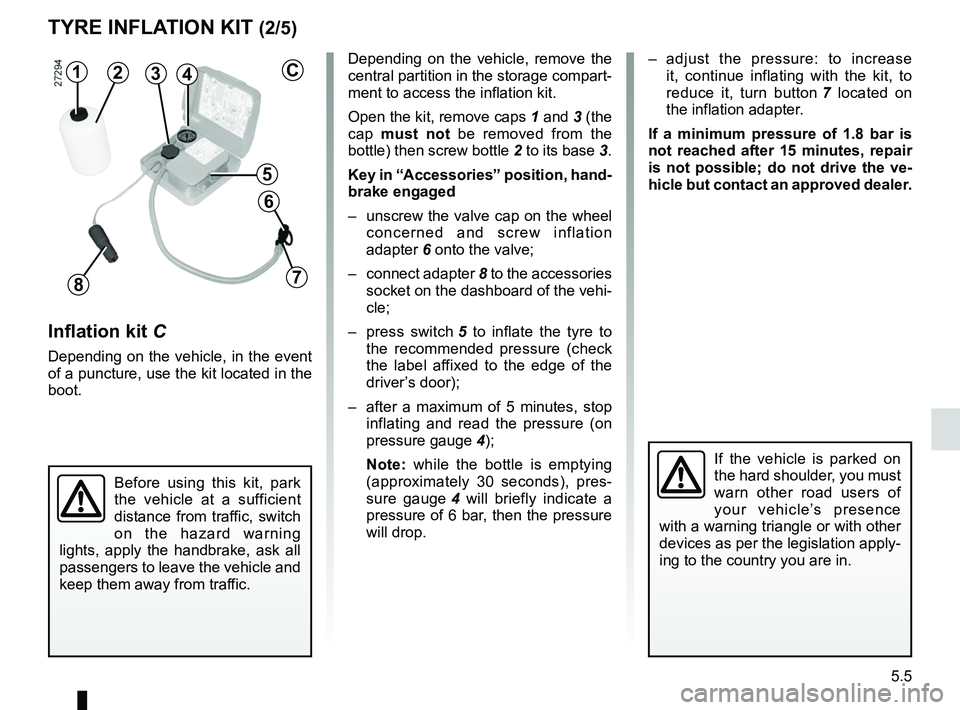
JauneNoirNoir texte
5.5
ENG_UD28764_1
Kit de gonflage des pneumatiques (L38 électrique - Renault)
ENG_NU_914-4_L38e_Renault_5
TYrE INFLATION KIT (2/5)
143
5
6
78
2Depending on the vehicle, remove the
central partition in the storage compart-
ment to access the inflation kit.
Open the kit, remove caps 1 and 3 (the
cap must not be removed from the
bottle) then screw bottle 2 to its base 3.
Key in “Accessories” position, hand-
brake engaged
– unscrew the valve cap on the wheel
concerned and screw inflation
adapter 6 onto the valve;
– connect adapter 8 to the accessories
socket on the dashboard of the vehi-
cle;
– press switch 5 to inflate the tyre to
the recommended pressure (check
the label affixed to the edge of the
driver’s door);
– after a maximum of 5 minutes, stop
inflating and read the pressure (on
pressure gauge 4);
Note: while the bottle is emptying
(approximately 30 seconds), pres -
sure gauge 4 will briefly indicate a
pressure of 6 bar, then the pressure
will drop. –
adjust the pressure: to increase
it, continue inflating with the kit, to
reduce it, turn button 7 located on
the inflation adapter.
If a minimum pressure of 1.8 bar is
not reached after 15 minutes, repair
is not possible; do not drive the ve-
hicle but contact an approved dealer.
Inflation kit C
Depending on the vehicle, in the event
of a puncture, use the kit located in the
boot.
Before using this kit, park
the vehicle at a sufficient
distance from traffic, switch
on the hazard warning
lights, apply the handbrake, ask all
passengers to leave the vehicle and
keep them away from traffic.
If the vehicle is parked on
the hard shoulder, you must
warn other road users of
your vehicle’s presence
with a warning triangle or with other
devices as per the legislation apply-
ing to the country you are in.
C
Page 143 of 195
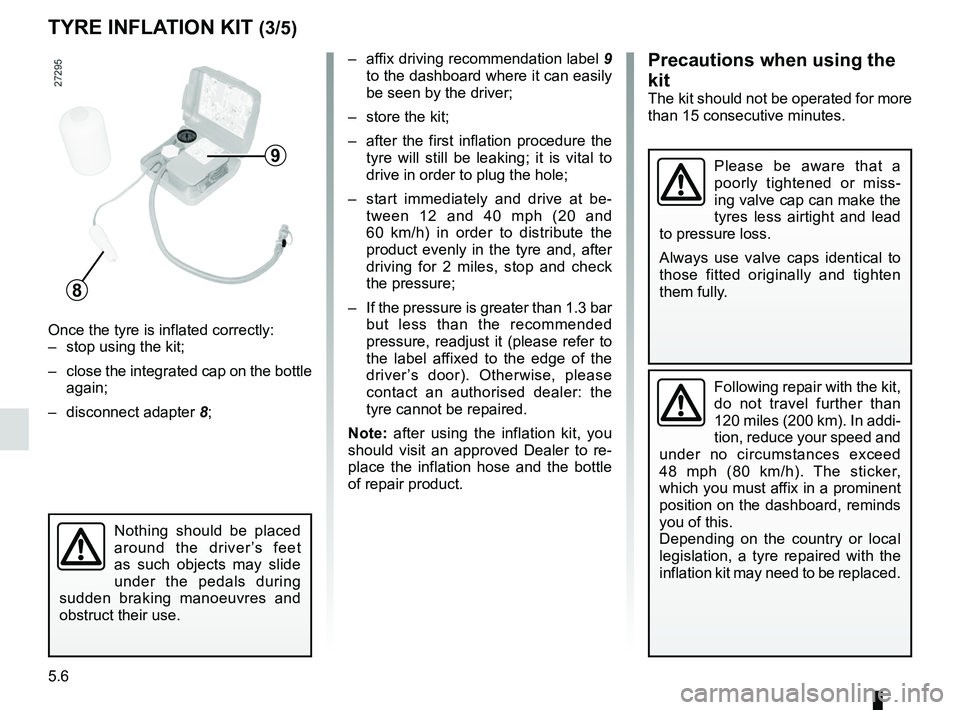
5.6
ENG_UD28764_1
Kit de gonflage des pneumatiques (L38 électrique - Renault)
ENG_NU_914-4_L38e_Renault_5
Jaune NoirNoir texte
TYrE INFLATION KIT (3/5)
9
8
– affix driving recommendation label 9
to the dashboard where it can easily
be seen by the driver;
– store the kit;
– after the first inflation procedure the
tyre will still be leaking; it is vital to
drive in order to plug the hole;
– start immediately and drive at be -
tween 12 and 40 mph (20 and
60 km/h) in order to distribute the
product evenly in the tyre and, after
driving for 2 miles, stop and check
the pressure;
– If the pressure is greater than 1.3 bar
but less than the recommended
pressure, readjust it (please refer to
the label affixed to the edge of the
driver ’s door). Otherwise, please
contact an authorised dealer: the
tyre cannot be repaired.
Note: after using the inflation kit, you
should visit an approved Dealer to re -
place the inflation hose and the bottle
of repair product.Precautions when using the
kit
The kit should not be operated for more
than 15 consecutive minutes.
Nothing should be placed
around the driver ’s feet
as such objects may slide
under the pedals during
sudden braking manoeuvres and
obstruct their use.
Once the tyre is inflated correctly:
– stop using the kit;
– close the integrated cap on the bottle
again;
– disconnect adapter 8;
Following repair with the kit,
do not travel further than
120 miles (200 km). In addi -
tion, reduce your speed and
under no circumstances exceed
48 mph (80 km/h). The sticker,
which you must affix in a prominent
position on the dashboard, reminds
you of this.
Depending on the country or local
legislation, a tyre repaired with the
inflation kit may need to be replaced.
Please be aware that a
poorly tightened or miss -
ing valve cap can make the
tyres less airtight and lead
to pressure loss.
Always use valve caps identical to
those fitted originally and tighten
them fully.
Page 144 of 195
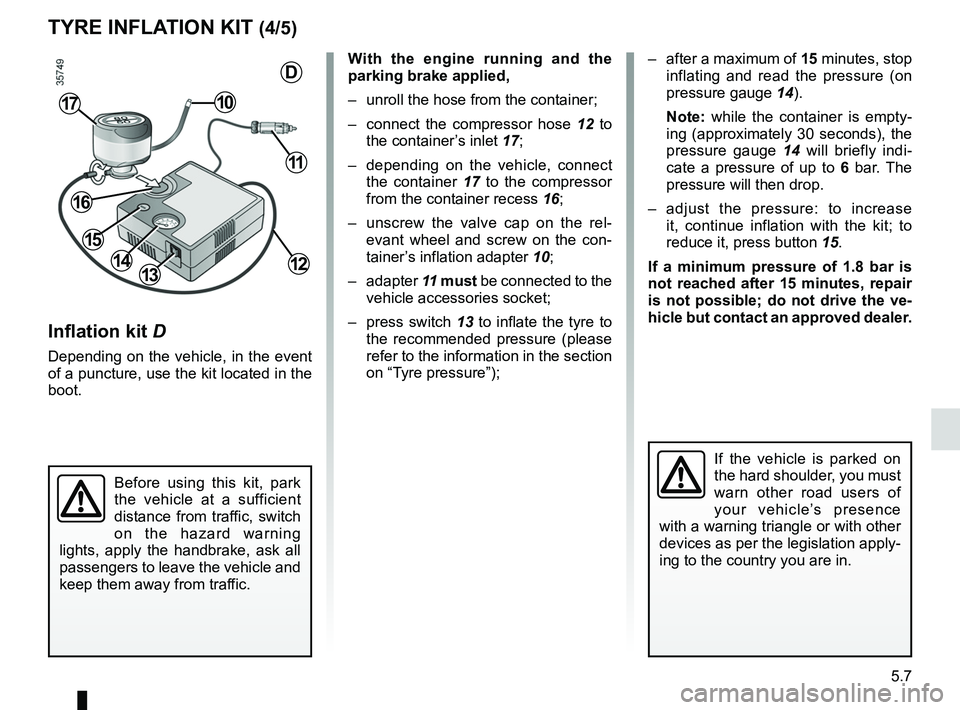
JauneNoirNoir texte
5.7
ENG_UD28764_1
Kit de gonflage des pneumatiques (L38 électrique - Renault)
ENG_NU_914-4_L38e_Renault_5
TYrE INFLATION KIT (4/5)
Inflation kit D
Depending on the vehicle, in the event
of a puncture, use the kit located in the
boot.
Before using this kit, park
the vehicle at a sufficient
distance from traffic, switch
on the hazard warning
lights, apply the handbrake, ask all
passengers to leave the vehicle and
keep them away from traffic.
1314
1017
11
12
16
15
DWith the engine running and the
parking brake applied,
– unroll the hose from the container;
– connect the compressor hose 12 to
the container’s inlet 17;
– depending on the vehicle, connect
the container 17 to the compressor
from the container recess 16;
– unscrew the valve cap on the rel -
evant wheel and screw on the con -
tainer’s inflation adapter 10;
– adapter 11 must be connected to the
vehicle accessories socket;
– press switch 13 to inflate the tyre to
the recommended pressure (please
refer to the information in the section
on “Tyre pressure”); –
after a maximum of 15 minutes, stop
inflating and read the pressure (on
pressure gauge 14).
Note: while the container is empty -
ing (approximately 30 seconds), the
pressure gauge 14 will briefly indi -
cate a pressure of up to 6 bar. The
pressure will then drop.
– adjust the pressure: to increase
it, continue inflation with the kit; to
reduce it, press button 15.
If a minimum pressure of 1.8 bar is
not reached after 15 minutes, repair
is not possible; do not drive the ve-
hicle but contact an approved dealer.
If the vehicle is parked on
the hard shoulder, you must
warn other road users of
your vehicle’s presence
with a warning triangle or with other
devices as per the legislation apply-
ing to the country you are in.
Page 145 of 195
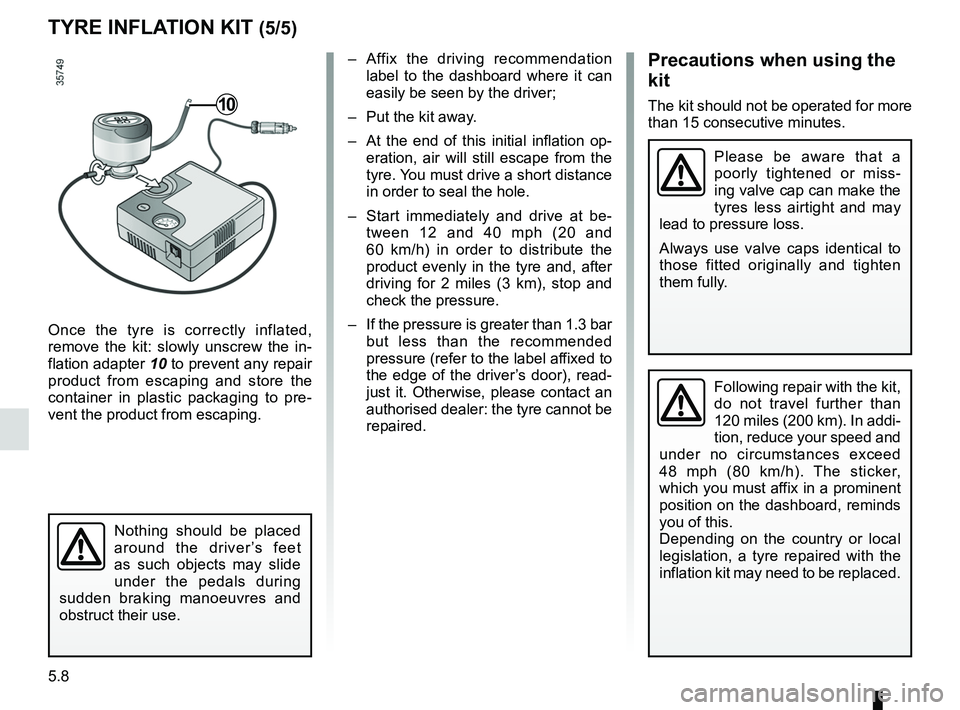
5.8
ENG_UD28764_1
Kit de gonflage des pneumatiques (L38 électrique - Renault)
ENG_NU_914-4_L38e_Renault_5
TYrE INFLATION KIT (5/5)
Once the tyre is correctly inflated,
remove the kit: slowly unscrew the in -
flation adapter 10 to prevent any repair
product from escaping and store the
container in plastic packaging to pre -
vent the product from escaping.
– Affix the driving recommendation
label to the dashboard where it can
easily be seen by the driver;
– Put the kit away.
– At the end of this initial inflation op-
eration, air will still escape from the
tyre. You must drive a short distance
in order to seal the hole.
– Start immediately and drive at be -
tween 12 and 40 mph (20 and
60 km/h) in order to distribute the
product evenly in the tyre and, after
driving for 2 miles (3 km), stop and
check the pressure.
– If the pressure is greater than 1.3 bar
but less than the recommended
pressure (refer to the label affixed to
the edge of the driver’s door), read-
just it. Otherwise, please contact an
authorised dealer: the tyre cannot be
repaired.Precautions when using the
kit
The kit should not be operated for more
than 15 consecutive minutes.
Nothing should be placed
around the driver ’s feet
as such objects may slide
under the pedals during
sudden braking manoeuvres and
obstruct their use.
10
Please be aware that a
poorly tightened or miss -
ing valve cap can make the
tyres less airtight and may
lead to pressure loss.
Always use valve caps identical to
those fitted originally and tighten
them fully.
Following repair with the kit,
do not travel further than
120 miles (200 km). In addi -
tion, reduce your speed and
under no circumstances exceed
48 mph (80 km/h). The sticker,
which you must affix in a prominent
position on the dashboard, reminds
you of this.
Depending on the country or local
legislation, a tyre repaired with the
inflation kit may need to be replaced.
Page 146 of 195

changing a wheel.................................. (up to the end of the DU)
puncture ................................................ (up to the end of the DU)
lifting the vehicle changing a wheel ............................ (up to the end of the DU)
5.9
ENG_UD23714_3
Changement de roue (L38 - X38 - Renault)
ENG_NU_914-4_L38e_Renault_5
Vehicles equipped with a jack
and wheelbrace
If necessary, remove the wheel trim.
– Use the wheelbrace 3 to slacken off
the wheel bolts. Position it so as to
be able to push from above;
– place the jack 4 horizontally; the jack
head must be lined up with the sill 1
closest to the wheel concerned, as
shown by arrow 2.
– start cranking the jack up by hand to
align the base plate (which should be
pushed slightly under the vehicle);
– turn the wheelbrace until the wheel
lifts off the ground;
– undo the bolts and take off the wheel;
– fit the emergency spare wheel on the
central hub and turn it to locate the
mounting holes in the wheel and the
hub.
Changing a wheel
CHANgINg A WHEEL (1/2)
Switch on the hazard warn-
ing lights.
Keep the vehicle away from
traffic and on a level sur -
face where it will not slip (if neces -
sary, place a solid support under the
jack base).
Engage the handbrake and put the
gearstick in position P.
Ask all the passengers to leave the
vehicle and keep them away from
traffic.
3
4
12
To prevent any risk of injury
or damage to the vehi -
cle, raise the jack until the
wheel you are replacing is
a maximum of 3 centimetres off the
ground.
If the vehicle is not equipped with a
jack or wheelbrace, you can obtain
these from your authorised dealer.
If the vehicle is parked on
the hard shoulder, you must
warn other road users of
your vehicle’s presence
with a warning triangle or with other
devices as per the legislation apply-
ing to the country you are in.
Page 147 of 195
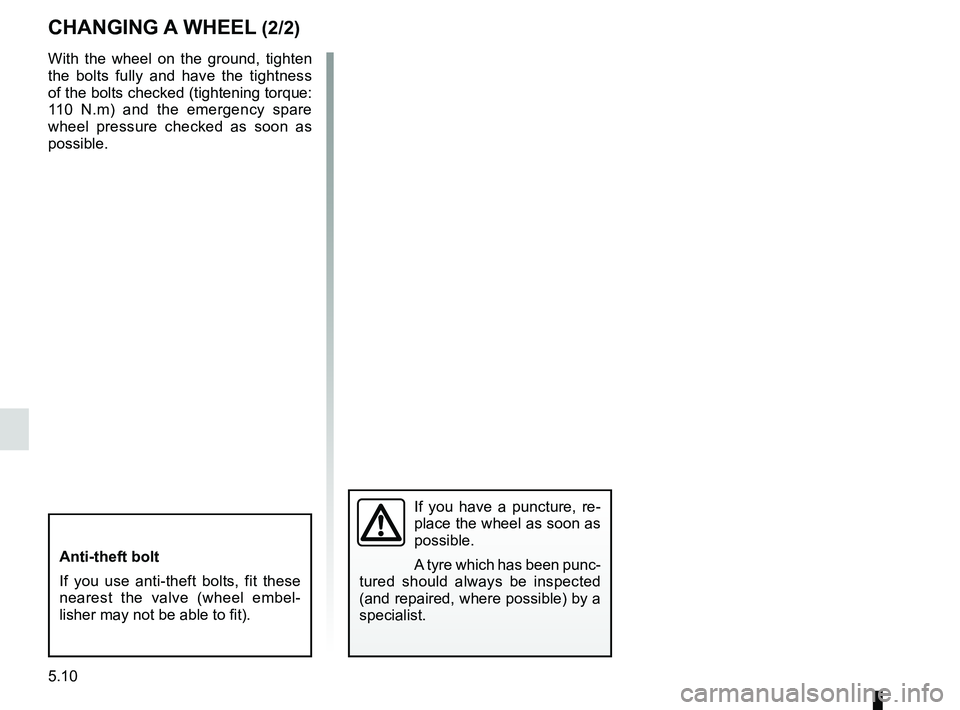
5.10
ENG_UD23714_3
Changement de roue (L38 - X38 - Renault)
ENG_NU_914-4_L38e_Renault_5
CHANgINg A WHEEL (2/2)
If you have a puncture, re -
place the wheel as soon as
possible.
A tyre which has been punc-
tured should always be inspected
(and repaired, where possible) by a
specialist.
Anti-theft bolt
If you use anti-theft bolts, fit these
nearest the valve (wheel embel -
lisher may not be able to fit).
With the wheel on the ground, tighten
the bolts fully and have the tightness
of the bolts checked (tightening torque:
110 N.m) and the emergency spare
wheel pressure checked as soon as
possible.
Page 148 of 195
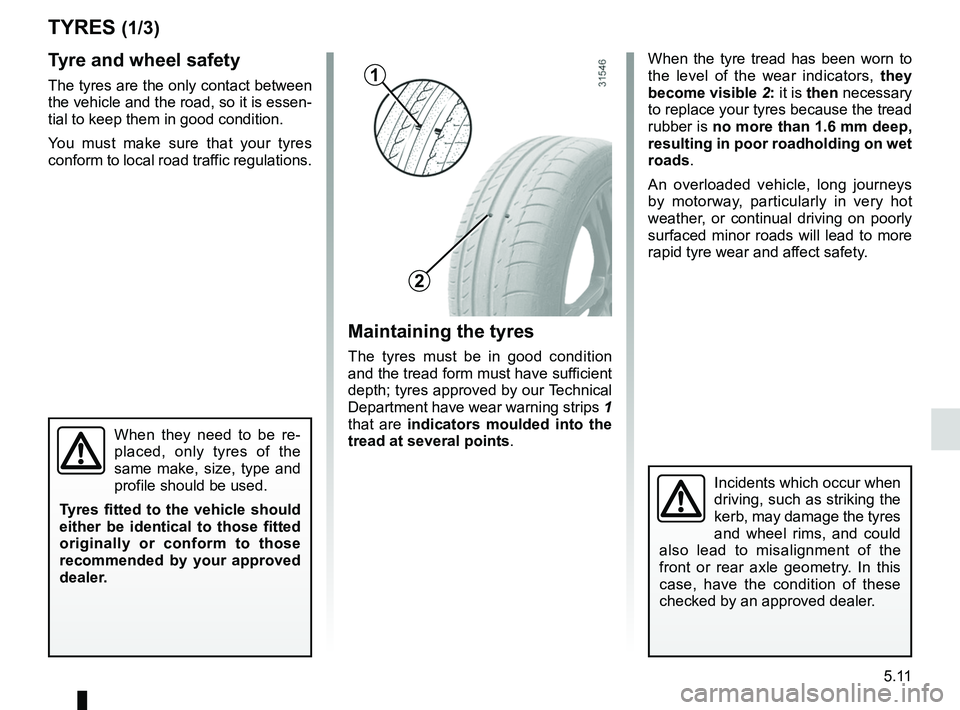
tyres ...................................................... (up to the end of the DU)
wheels (safety) ..................................... (up to the end of the DU)
5.11
ENG_UD23715_3
Pneumatiques (L38 - X38 - Renault)
ENG_NU_914-4_L38e_Renault_5
Tyres (tyre and wheel safety, use in winter)
TYrEs (1/3)
maintaining the tyres
The tyres must be in good condition
and the tread form must have sufficient
depth; tyres approved by our Technical
Department have wear warning strips 1
that are indicators moulded into the
tread at several points.
Tyre and wheel safety
The tyres are the only contact between
the vehicle and the road, so it is essen-
tial to keep them in good condition.
You must make sure that your tyres
conform to local road traffic regulations. When the tyre tread has been worn to
the level of the wear indicators,
they
become visible 2: it is then necessary
to replace your tyres because the tread
rubber is no more than 1.6 mm deep,
resulting in poor roadholding on wet
roads.
An overloaded vehicle, long journeys
by motorway, particularly in very hot
weather, or continual driving on poorly
surfaced minor roads will lead to more
rapid tyre wear and affect safety.
When they need to be re -
placed, only tyres of the
same make, size, type and
profile should be used.
Tyres fitted to the vehicle should
either be identical to those fitted
originally or conform to those
recommended by your approved
dealer.
Incidents which occur when
driving, such as striking the
kerb, may damage the tyres
and wheel rims, and could
also lead to misalignment of the
front or rear axle geometry. In this
case, have the condition of these
checked by an approved dealer.
2
1
Page 149 of 195
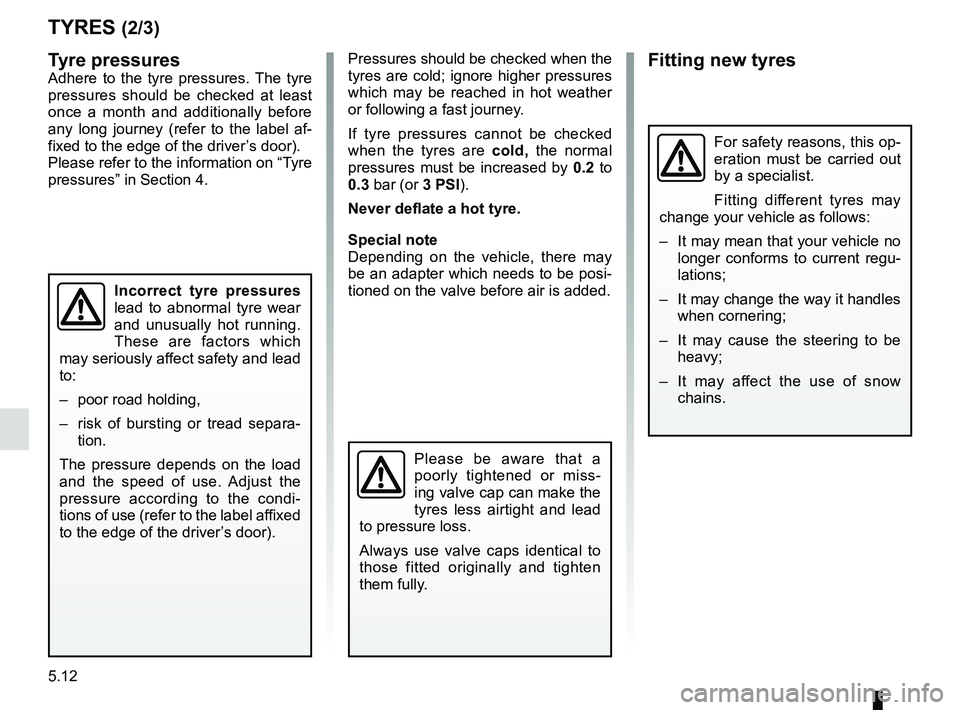
tyre pressure.......................................................... (current page)
5.12
ENG_UD23715_3
Pneumatiques (L38 - X38 - Renault)
ENG_NU_914-4_L38e_Renault_5
Jaune NoirNoir texte
TYrEs (2/3)
Tyre pressures
Adhere to the tyre pressures. The tyre
pressures should be checked at least
once a month and additionally before
any long journey (refer to the label af -
fixed to the edge of the driver’s door).
Please refer to the information on “Tyre
pressures” in Section 4. Pressures should be checked when the
tyres are cold; ignore higher pressures
which may be reached in hot weather
or following a fast journey.
If tyre pressures cannot be checked
when the tyres are
cold, the normal
pressures must be increased by 0.2 to
0.3 bar (or 3 PsI).
Never deflate a hot tyre.
special note
Depending on the vehicle, there may
be an adapter which needs to be posi-
tioned on the valve before air is added.Fitting new tyres
Incorrect tyre pressures
lead to abnormal tyre wear
and unusually hot running.
These are factors which
may seriously affect safety and lead
to:
– poor road holding,
– risk of bursting or tread separa -
tion.
The pressure depends on the load
and the speed of use. Adjust the
pressure according to the condi -
tions of use (refer to the label affixed
to the edge of the driver’s door).
Please be aware that a
poorly tightened or miss -
ing valve cap can make the
tyres less airtight and lead
to pressure loss.
Always use valve caps identical to
those fitted originally and tighten
them fully.
For safety reasons, this op-
eration must be carried out
by a specialist.
Fitting different tyres may
change your vehicle as follows:
– It may mean that your vehicle no
longer conforms to current regu-
lations;
– It may change the way it handles
when cornering;
– It may cause the steering to be
heavy;
– It may affect the use of snow
chains.
Page 150 of 195
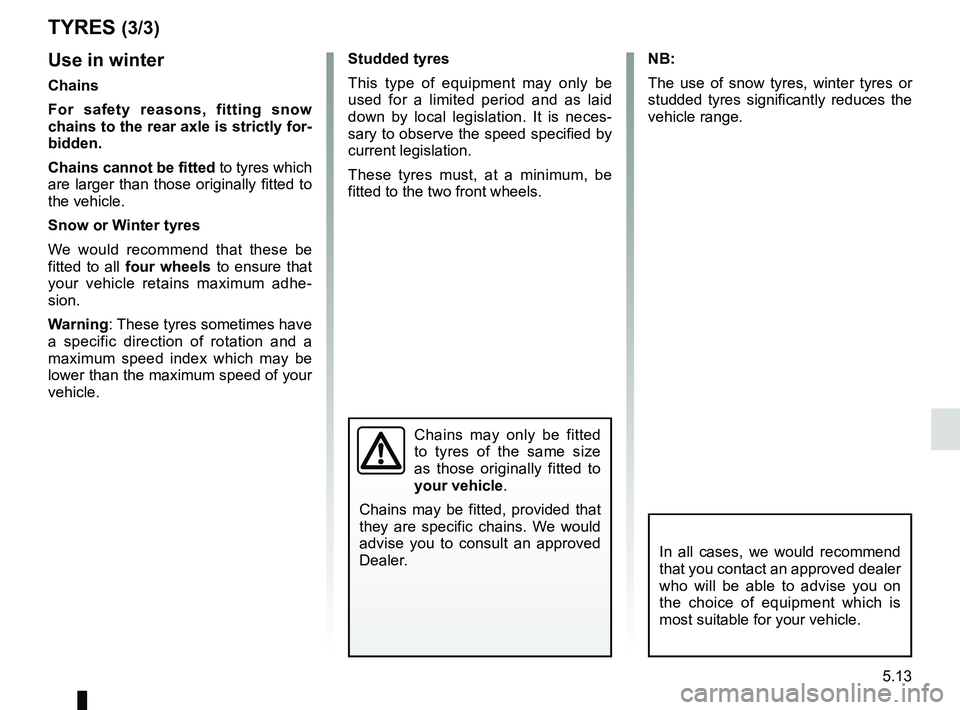
JauneNoirNoir texte
5.13
ENG_UD23715_3
Pneumatiques (L38 - X38 - Renault)
ENG_NU_914-4_L38e_Renault_5
TYrEs (3/3)
Use in winter
Chains
For safety reasons, fitting snow
chains to the rear axle is strictly for-
bidden.
Chains cannot be fitted to tyres which
are larger than those originally fitted to
the vehicle.
snow or Winter tyres
We would recommend that these be
fitted to all four wheels to ensure that
your vehicle retains maximum adhe -
sion.
Warning: These tyres sometimes have
a specific direction of rotation and a
maximum speed index which may be
lower than the maximum speed of your
vehicle.
Chains may only be fitted
to tyres of the same size
as those originally fitted to
your vehicle.
Chains may be fitted, provided that
they are specific chains. We would
advise you to consult an approved
Dealer.
In all cases, we would recommend
that you contact an approved dealer
who will be able to advise you on
the choice of equipment which is
most suitable for your vehicle.
studded tyres
This type of equipment may only be
used for a limited period and as laid
down by local legislation. It is neces -
sary to observe the speed specified by
current legislation.
These tyres must, at a minimum, be
fitted to the two front wheels. NB:
The use of snow tyres, winter tyres or
studded tyres significantly reduces the
vehicle range.